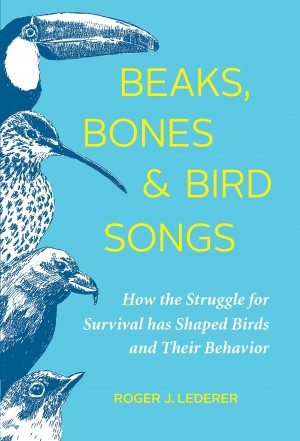 THIS IS THE INTRODUCTION TO MY NEWEST BOOK
THIS IS THE INTRODUCTION TO MY NEWEST BOOK
Look outside your window, take a walk, go fishing, watch a video or do anything else that allows you to see birds in the wild. You may get the impression that birds are blithely going about their business, happily chirping, singing, scratching among the leaves, flitting from branch to branch, clambering up a tree trunk, or soaring through the sky barely moving a feather. Looks like an easy life. Cultural symbols like the dove representing peace, the bluebird signifying happiness and the robin as the harbinger of spring reinforce the idea that birds have not a care in the world. Don’t we wish we could be “free as a bird?” It is not like that at all. What we don’t see are the arduous challenges a bird faces every moment. According to David Attenborough, “There are some four million different kinds of animals and plants in the world. Four million different solutions to the problems of staying alive.”
The Institute for Bird Populations estimates the annual survivorship of White-eyed Vireos in the southeastern U.S. at 2.4 percent from year to year; that means that 97.6 percent of the vireos die each year. In the northwest, only 6.1 percent of Downy Woodpeckers survive from one year to the next. Bigger birds do better. White-fronted Geese have a 63.5 percent survival rate in the U.K. and 60 percent of Mandarin Ducks survive to the next year in eastern China. Diseases, weather and climate change, predation, hunting, loss of habitat, colliding with human structures, starvation, and competition from alien species all take their toll.
Birds have a difficult life, but unlike humans, birds don’t seem to get closer to their demise with age; most birds, after reaching maturity, have an equal chance of dying at all times of their life – they don’t really age physically, but live a precarious life. Sick or injured birds are rarely seen in the wild as any decline in their heath or injury puts them at immediate risk of death, so you only see healthy birds on your bird walks.
Birds have to be on task every moment of every day. They have to use their senses to find food, migrate, withstand the weather, avoid predators, and face a myriad of other trials. This book is about the abilities, strategies, and behaviors birds possess and employ to survive from one day to the next. Only the most physiologically, anatomically, and behaviorally well-tuned birds successfully meet these challenges and go on to the most important goal in their life, reproduction.
Evolution has been at work on birds for over 200 million years, shaping them into the adept and adroit organisms they are. Today birds not only face the challenges that natural selection throws at them, but an entirely new set of obstacles, thanks to us. Shortly after humans came on the scene, things started to change. At first birds were part of early humans’ diet. Then agriculture came along, usurping habitat but also inadvertently providing food for birds. As culture developed, bird feathers, bills, and bones became adornments for human cultures; later birds were domesticated for meat or eggs. Bird hunting became more efficient with the invention of guns and as civilization spread, habitat shrank. Massive destruction of wildlife of all sorts was common, including the commercial hunting of many bird species for food and feathers, until the passage of the Lacy Act in the U.S. in 1900 which became the first federal law protecting wildlife. The later Migratory Bird Treaty Act of 1918 further protected migratory birds. This law has worked well, but since many bird species live in or migrate through areas of the world that don’t pay much attention to the needs of birds or their protection, about 1400 of 10,000 bird species of the world are threatened with extinction.
So in addition to the everyday trials that birds have to face from the natural environment, they encounter additional obstacles that evolution has not prepared them for. Birds have always contracted diseases, but humans have altered the environment which allows diseases to spread faster. We have destroyed habitats and replaced the outdoors with cities, highways, tall buildings with windows, transmission towers and lines, microwave antennas, wind turbines, lights, and millions of cats. A solar plant in the Mojave Desert concentrates sun’s rays so strongly that birds are incinerated if they happen to wander by. Birds have evolved rather amazing and often unique adaptations to the environment, but as the world changes, those adaptations become increasingly less effective. Birds never evolved defenses against windows or lights, buildings or towers or the large number of our feline friends. Climate change has caused changes in bird migration patterns, but what the long term effect will be is unknown.
With ornithological science as the background, my book explores the common and unusual ways birds put into operation their physical and mental adaptation. You will learn how birds use their abilities to see ultraviolet, find food without seeing or touching it, fly thousands of miles non-stop, maneuver adroitly through thick forests with amazing speed, navigate by smell, survive extremes of weather, share the resources of their community, change their songs in noisy cities, and other amazing things birds have to do to simply make it to tomorrow and to face the challenges of a changing planet
Courtship, mating, nest-building, incubation, and care of young, although fascinating subjects, will not be addressed here. Those behaviors are only possible after the tribulations of everyday life have been successfully met and that’s what this book is all about -what everyday challenges does a bird face and what does it have to do to survive?
I just bought this book and have read almost all of it. I can barely put it down. I think it’s the most interesting and easily understood bird books I own. I highly recommend it to any bird-lover.